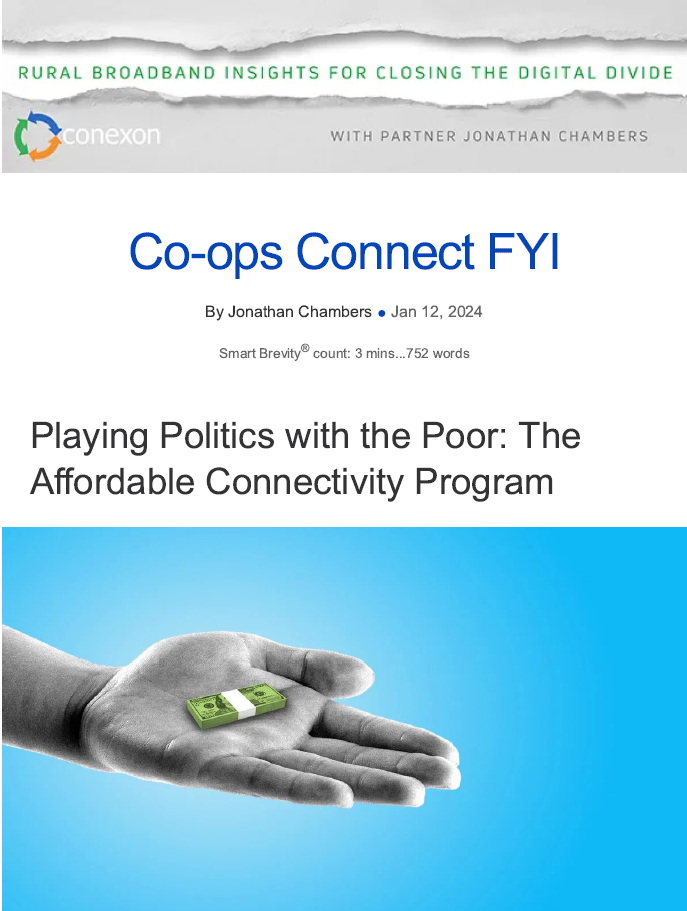Playing Politics with the Poor: The Affordable Connectivity Program
January 12, 2024
FCC Chair Jessica Rosenworcel informed Congress this week that without an additional $6 billion in funding for the Affordable Connectivity Program (ACP), the program will run out of funds mid-year.
- The program, created with over $14 billion, is less than 2 years old.
- Another $6 billion will keep the program going only until the end of the year.
- And then they will go through this same sky-is-falling exercise all over again.
According to Senator Richard Blumenthal, one of the advocates of ACP:
“These funds are a lifeline for struggling families, and yet they are at risk of disappearing if Republicans succeed in cutting them from the federal budget. Millions of Americans could be at risk of losing access to affordable internet — jeopardizing their employment, ability to pursue educational opportunities, access to health care services and so much more. We cannot and will not let that happen.”
(emphasis added)
The bigger picture:
“Lifeline” is a curious choice of words for ACP. There has been a Lifeline program administered by the FCC since the 1980s that is not at risk of disappearing — and it can do exactly what the ACP purports to do.
Lifeline vs. ACP
The broad differences between the Lifeline program and ACP are:

Why it matters:
At current levels, ACP has grown larger than all other FCC Universal Service programs combined.
The Universal Service programs:
- Are decades old and ensure all Americans, regardless of where they live or their level of income, have access to telecommunications and information services.
- Include funding for rural areas, schools, libraries, rural health care facilities, as well as funding for the hearing-impaired.
The Evolution of ACP
How did ACP grow so large so fast, so that it is financially out of control?
Three factors stand out:
1. Congress set the ACP discount benefit at $30 per month, and then the Biden Administration strongly encouraged companies to create a $30 broadband plan so services would be free to the consumer. The FCC’s experience with other Universal Service programs has demonstrated that free services subsidized by the public often spiral out of control.
2. While the Lifeline program addresses the poorest households, ACP set the eligibility threshold to twice the poverty level, making tens of millions more households now eligible for a low-income benefit.
3. Most of the ACP money has gone to mobile services, not residential broadband. Over a decade ago, Lifeline support for mobile services overwhelmed and nearly killed that program. ACP is repeating a knowable history.
The big picture:
Even if Congress appropriates more funding for ACP, it is unlikely to do so without some reform to rein in spending.
- Congress will not permanently fund ACP, certainly not by annually appropriating $10-20 billion for what would effectively be a new entitlement program.
What Should Be Done
Are the advocates for the program interested in a practical solution? If so, here’s at least one.
Replace ACP with a new Lifeline program that:
1. Increases eligibility to 150% of the poverty line.
2. Increases the Lifeline subsidy from $9.25 per month to $30 per month for those at or below the poverty line and $20 per month for those at or below 150% of the poverty line.
3. Restricts eligibility to residential fixed broadband and eliminates subsidies for mobile services.
Why this solution works:
- These changes would direct funding to those who need it most for the services most in need of support.
- These changes would also remove the program from the annual grappling over spending bills that occurs on Capitol Hill.
- Unlike ACP, Lifeline is and will continue to be a sustainable program.
The bottom line:
There is ample time for the FCC to change the rules for Lifeline to a program that accomplishes the goals of ACP without the budget-busting features of ACP.
Why bother:
When Conexon conducts a feasibility study for a fiber network, we review the demographics of the service territory, including the median household income.
- In the studies we’ve completed for electric co-ops (nearly 300 to date), more than 50% of co-op members qualify for ACP.
- Therefore, rural America has a stake in the sustainability of ACP, especially if it is tailored and gets the priorities right.
Should we, as a group of rural cooperatives and internet service providers, petition the FCC to amend the Lifeline program? Let me know.
